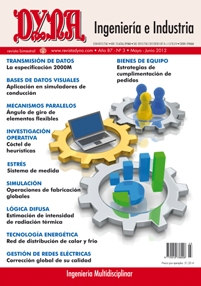STUDY OF ROTARY ANGLE FLEXIBLE HINGES IN PARALLEL MECHANISM
Keywords:
Mecanismo paralelo, elemento flexible, ángulo de giro, movimiento parásito, Parallel mechanism, flexible hinge, rotation angle, parasitic movement.Abstract
ABSTRACT This paper analyses the flexible hinge parasitic error in function of the rotation angle in the 0-45º range. First, an analysis of the different geometries -taking into account considerations such as the stiffness and the rotation angle- is carried out, and a new kinematic model of two degrees of freedom parallel mechanism is developed. This mechanism consists of a exible system that allows us to obtain the azimuth and elevation angles. The model developed is based on the Denavit-Hartenberg method. The kinematic chain containing flexible elements is therefore modelled by adding ransformation matrices that consider the angle and translation error of those elements with respect to the initial reference systems. Subsequently, he flexible hinge geometric parameters are determined, by means of a simulation software based on the finite element method in order to obtain a system that allows us to perform the desired rotations. Finally, the element has been experimentally characterized, for two selected materials: aluminium EN AW-7075 and steel F-1430 and the rotation axis error in function of the rotated angle is obtained. This characterization let us observe which material is more suitable in function of the work range, and know for a particular application, the rotation magnitude that can be achieved with the flexible element in function of the desired accuracy.Downloads
Published
2012-05-01
Issue
Section
ARTICULOS

